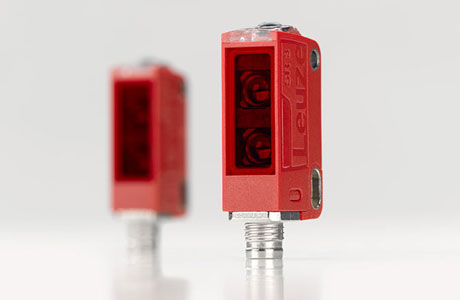Key Takeaway
The basics of photoelectric sensors involve detecting objects using a light beam. A light emitter sends a beam that’s received by a detector. When an object interrupts or reflects the light, the sensor detects this change and triggers a response. This technology is ideal for detecting small or hard-to-see objects.
There are different types of photoelectric sensors, including through-beam, reflective, and diffuse sensors. Each type works in different ways to suit specific applications, such as automated machinery, packaging, and material handling.
What is a Photoelectric Sensor and How Does It Work?
A photoelectric sensor is a device that uses light to detect the presence, absence, or distance of an object. It works by emitting a beam of light, usually infrared or visible, from a transmitter, which then gets reflected or interrupted by an object. The sensor then analyzes the changes in the light to detect objects. The entire process happens almost instantly, making these sensors highly reliable in automation. For newly joined engineers, understanding that the core principle is light reflection or interruption is the first step to mastering how these sensors operate in industrial environments.

Different Types of Photoelectric Sensors Explained
There are three main types of photoelectric sensors: through-beam, retroreflective, and diffuse. In through-beam sensors, the transmitter and receiver are placed separately, and detection happens when an object interrupts the light beam between them. This type is ideal for long-distance detection. Retroreflective sensors, on the other hand, combine the transmitter and receiver into one unit and use a reflector to bounce the light back. These sensors are often used in environments with complex backgrounds since the reflector helps in differentiating the object. Lastly, diffuse sensors detect objects by reflecting light directly off the object itself. They are more compact and suited for shorter ranges.
When you’re a new engineer, it’s crucial to understand the strengths of each type. Through-beam sensors work best when precise, long-range detection is needed, while diffuse sensors are perfect for tight spaces and versatile applications. Retroreflective sensors thrive in environments with reflective surfaces. Understanding these distinctions will ensure you choose the right sensor for your project, improving efficiency and accuracy in automation.
Key Components and Working Principles
Every photoelectric sensor has key components that work together to ensure accurate detection. The main parts include the light source (usually an LED), the receiver (photodetector), signal amplifier, and output circuitry. The light source emits a beam, and when this beam is interrupted or reflected back, the receiver detects the change. The signal amplifier then boosts this signal, making sure it’s strong enough for the system to process. The final part, the output circuitry, sends the signal to a machine or control unit, triggering an action like stopping a conveyor or counting an item.
For you as a new engineer, understanding how these components interact is essential. Troubleshooting becomes much easier when you know how each part works. Whether it’s a weak signal or a faulty light source, identifying the issue quickly will minimize downtime and improve overall productivity. In automation, your expertise in selecting and maintaining sensors ensures smooth operations.
Common Applications of Photoelectric Sensors in Industry
Photoelectric sensors are incredibly versatile and are used across various industries. In packaging lines, they help detect bottles, boxes, or containers, ensuring each one is correctly positioned before sealing or labeling. This is essential for maintaining high production speeds and accuracy. In manufacturing, they count items on conveyors, ensuring that the right number of products reaches each stage of production. This kind of precision is critical to avoid waste or shortages.
Safety systems also rely heavily on photoelectric sensors to detect objects or personnel in hazardous areas. When an object is detected, the sensor can automatically stop machinery, preventing accidents. As an engineer, you’ll likely interact with these sensors regularly, especially in safety-critical environments. Knowing their applications and how they contribute to automation will help you optimize processes and enhance safety measures.
How to Choose the Right Type of Photoelectric Sensor
Selecting the right photoelectric sensor for your application is crucial for ensuring optimal performance. Through-beam sensors are ideal when long-distance detection is needed, as they provide precise and reliable detection across distances. If your environment has reflective surfaces, retroreflective sensors are a great choice because they can differentiate between the object and the background using a reflector. Diffuse sensors, however, are best for detecting objects at shorter distances or when space is limited, as they detect light reflected from the object directly.
When making a selection, it’s important to also consider environmental factors. Dust, moisture, and ambient light can affect sensor performance, so it’s essential to choose a sensor that can withstand these conditions. By matching the sensor type to your application’s needs, you’ll enhance efficiency, minimize errors, and improve overall productivity. This level of understanding ensures you make informed decisions, making your role in the industry more impactful.
Conclusion
Photoelectric sensors play a critical role in today’s automated industries. By understanding how they work, their types, and key components, you’re well on your way to mastering their use. Whether for object detection, counting, or safety applications, these sensors offer a flexible and reliable solution in various industrial scenarios. For any newly joined engineer, grasping these basics opens the door to effectively contributing to complex automated processes. With experience, you’ll learn to select, install, and maintain these sensors, ensuring that the automation systems you work with run smoothly and efficiently.
